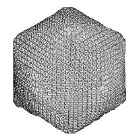Plant Pathology, Department of

James Van Etten Publications
Document Type
Article
Date of this Version
1-4-2008
Citation
THE JOURNAL OF BIOLOGICAL CHEMISTRY VOL. 283, NO. 1, pp. 184–193, January 4, 2008
DOI 10.1074/jbc.M706614200
PMID: 17974560 https://www.ncbi.nlm.nih.gov/pubmed/17974560
Abstract
GDP-D-mannose 4,6-dehydratase (GMD) is a key enzyme involved in the synthesis of 6-deoxyhexoses in prokaryotes and eukaryotes. Paramecium bursaria chlorella virus-1 (PBCV-1) encodes a functional GMD, which is unique among characterized GMDs because it also has a strong stereospecific NADPH-dependent reductase activity leading to GDP-D-rhamnose formation (Tonetti, M., Zanardi, D., Gurnon, J., Fruscione, F., Armirotti, A., Damonte, G., Sturla, L., De Flora, A., and Van Etten, J.L. (2003) J. Biol. Chem. 278, 21559–21565). In the present study we characterized a recombinant GMD encoded by another chlorella virus, Acanthocystis turfacea chlorella virus 1 (ATCV-1), demonstrating that it has the expected dehydratase activity. However, it also displayed significant differences when compared with PBCV-1 GMD. In particular, ATCV-1 GMD lacks the reductase activity present in the PBCV-1 enzyme.Using recombinant PBCV-1 and ATCV-1 GMDs, we determined that the enzymatically active proteins contain tightly bound NADPH and that NADPH is essential for maintaining the oligomerization status as well as for the stabilization and function of both enzymes. Phylogenetic analysis indicates that PBCV-1 GMD is the most evolutionary diverged of the GMDs. We conclude that this high degree of divergence was the result of the selection pressures that led to the acquisition of new reductase activity to synthesize GDP-D-rhamnose while maintaining the dehydratase activity in order to continue to synthesize GDP-L-fucose.


Comments
© 2008 by The American Society for Biochemistry and Molecular Biology, Inc.
Access via Pub Med